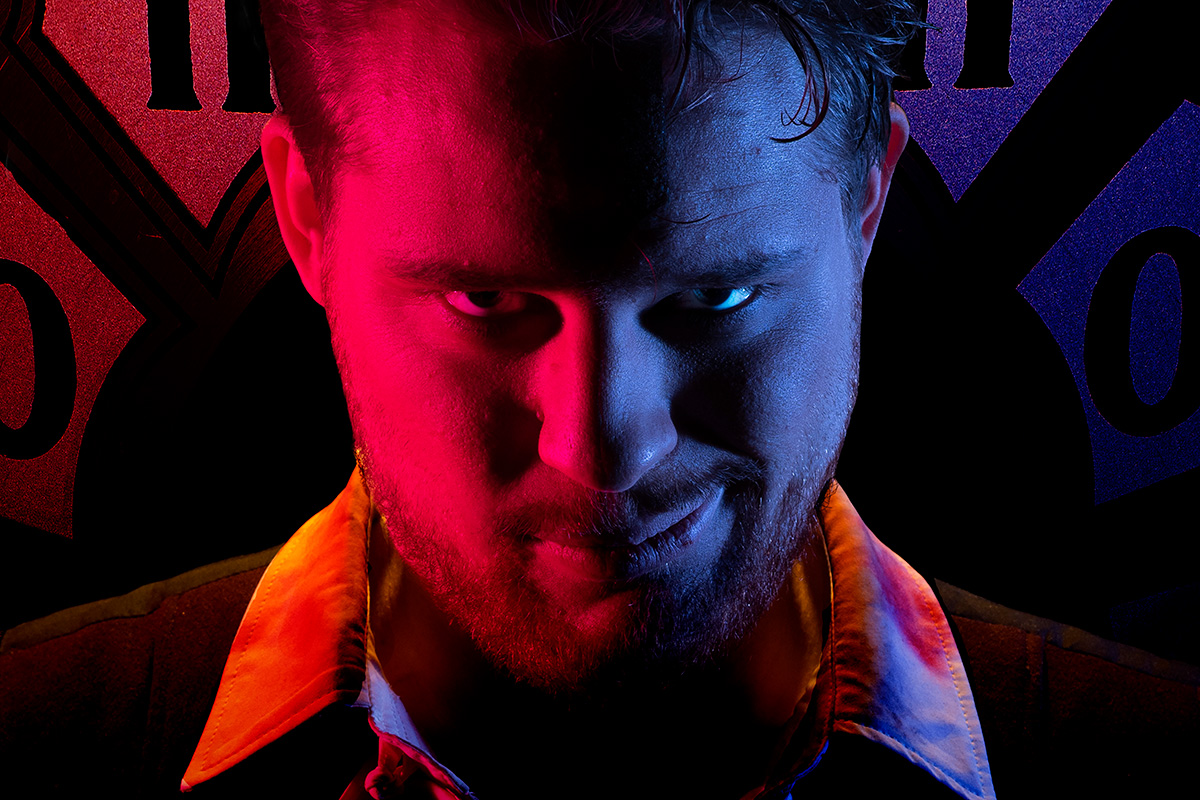
ryan
On Set Fun: Utah Union of Domestic Workers
by Ryan Jensen
September 30, 2019
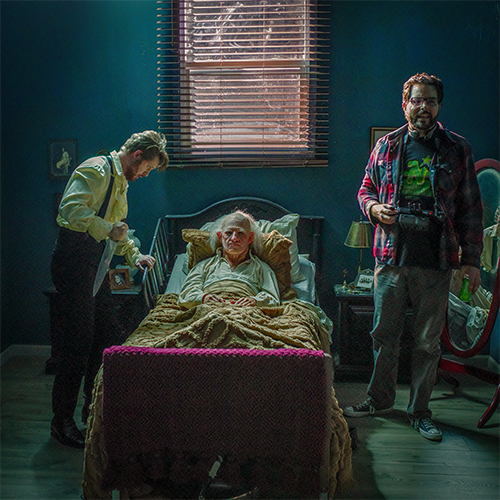
The following letter was written and prepared by our Line Producer John Lindquist as a practical joke. It’s main target was Producer/Director McClain Lindquist. It was presented to him half way through filming as a serious letter. It’s jokes like this that can drive a man to madness.
Producers of Tell-Tale Heart,
On behalf of the fine women and men dedicated to keeping houses and hotels clean and orderly, I send this correspondence with some trepidation.
It has come to our attention that on your film set the actions you’ve assigned to the domestic help provider as portrayed by the character Narrator, cast an unflattering light on all maids, house cleaners, manservants and butlers.
The domestic care industry has a long tradition of quality.
While domestic and household accidents are the leading cause of death in the country, servant upon employer violence constitutes a mere 38% of that number. The character of the Narrator is unfair to the 62% of our union members who do not participate in homicide.
We would also like to point out that of the 38% of members who are murderers, only 15% participate in dismemberment, and fewer that 3% bury their victims within the house—almost all of the entirety of the murders committed by domestic help result in the victim being discarded off premises.
Would you consider asking Mr. Poe to rewrite the story to have an ending in which the Narrator and his employer go for a walk? Perhaps they could have a difficult conversation about incontinence which would still provide some creative tension. While we respect Mr. Poe’s creative process, we are concerned with the damage to reputation to our union members.
Maybe Mr. Poe could have the police be the villains, as this seems more realistic.
Regards,
James “Jimmy” Boanerges
Authorized Representative of UUDW
Utah’s Own Hollywood
by Charles Lindquist
August 7, 2019

The only good movies come out of Hollywood, right? Wrong. Some of the greatest movies are not products of Hollywood. Films from Inglorious Basterds to Monty Python’s Life of Brian were not products of Hollywood. According to Los Angeles Magazine* as recent as 2016 only 7 of the 100 top-grossing live-action movies were filmed in Hollywood. It could be filmmakers are moving away from the Hollywood machine.
If not Hollywood, where are they being made? Utah for one. The upcoming adaptation of The Tell-Tale Heart is slated for filming in late 2019 at Redman studios in Salt Lake City. This film is completely home-grown in Utah.
Director McClain Lindquist, an Ogden native, said he wouldn’t consider filming anywhere but in Utah. For him there is a pride to live and breathe all things localized. Another talented Utahn working on this film, Chris Hanson, is an industry premier practical effects and makeup artist. Hanson is no stranger to working on Hollywood blockbusters, with the likes of Predator and Hereditary, but prefers to work at home.
The history of Utah in films is not the only benefit to filming in Utah, many film industry workers move to Utah to build a life in Utah. Joe Olivas, director of photography for The Tell-Tale Heart, says that one of the benefits of working in Utah is the natural beauty and great communities. He is happy to build a family here and establish roots here in Utah, Olivas and his wife are currently raising their son here in Utah.
One film that has inspired some of Lindquist’s previous work is Indiana Jones and The Last Crusade. The Opening of Indiana Jones and The Last Crusade was filmed in southern Utah. Utah is not a stranger to big-name films; Forrest Gump, The Sandlot, and Footloose were all filmed in Utah, and The Tell-Tale Heart plans to join the list of big movies on the state’s film resume.
*https://www.lamag.com/askchris/percentage-movies-filmed-in-los-angeles/
# # #
“The Tell Tale Heart” Creatively Rising Through the Floorboards with Distinct Vision in a Utah Produced Short Film
by Jared Cristensen
June 6, 2019

Ogden, Utah – A unique blend of classic literature, practical special effects, cast and crew camaraderie, and lastly a “conscious camera” approach is creating some serious internet hype. This local homegrown Utah production is beginning to bring Poe’s classic story, “The Tell Tale Heart,” to life as it continues to lunge towards the big-screen.

“The Tell Tale Heart” short film, a BassMint Production, is coming to life with its terrifying online presence, personified by pre-production dark art, including its stunning gothic film poster designed by Andy Walsh (yes that is the Eccles Art Center in Ogden, UT), its own locally produced comic book which is being co-designed based on the director, McClain Lindquist’s storyboards and by local favorite and world renowned artist Chris Bodily aka “Hatrobot”.
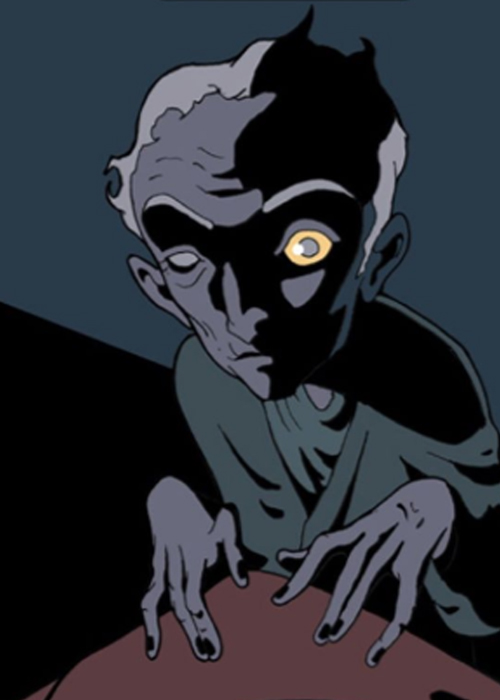
Production is steadily moving along with a handful of polished cast and crew hirings including the procuring of the incomparable Chris Hanson, a horror film special effects veteran, and James C. Morris, a long-time talented actor who has been cast as the Old Man. Hanson and Morris have been working together on numerous films and various other projects for years dating back to their days working at nationally renowned Rocky Point Haunted House. “I was the Make-up Director for Rocky Point the last ten years they were operating,” said Hanson, the film’s Special Effects Director who’s had a successful career in Special Effects. “The coolest thing that happened in my young career was sitting in David Lynch’s house,” Hanson said. “Where I got to apply lots of make-up and gore for ‘Lost Highway’”.
Hanson mentioned working for Steve Wang painting werewolves for the film “UNDERWORLD” as another highlight of his stating he felt Wang is the greatest artist in the effects industry. Hanson has been involved in many films like “The X Files”, “Hellboy”, “Men In Black”, “The Green Mile”, “Vampires”, and “Hereditary” to name only a few. “I’ve worked on completely unforgettable themes,” Hanson said.
Hanson has been heavily involved in the early production of the The Tell Tale Heart short film from the “Floating Bloody Heart” video where he designed, created, and operated the heart that is shown in the video (link below) to some designing for various scenes involving the Old Man, whom James C. Morris has been cast to play the role of. https://www.youtube.com/watch?v=CLT2YApw6qY
Hanson added about his working relationship with Morris “The biggest carry over from Rocky Point has been continuing to work with James since then,” Hanson said. “I’d just glue stuff to the guy and he’d act his heart out.”
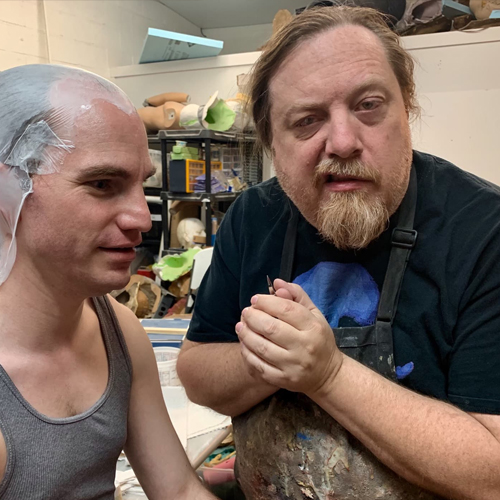
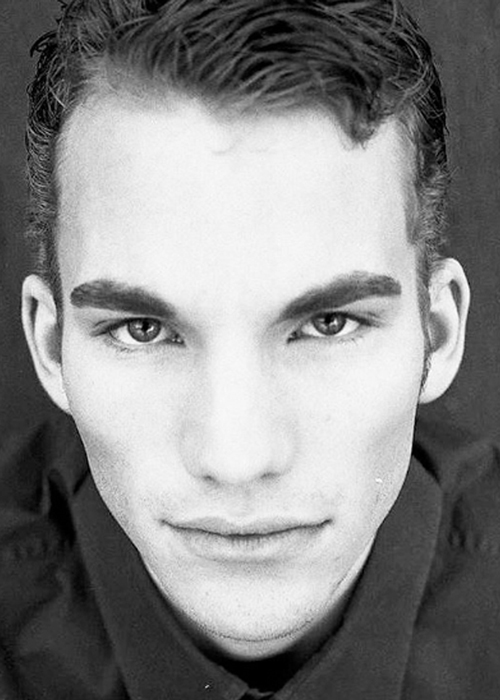
“We have a great symbiotic type relationship together,” Morris said of Hanson. Morris, who’s also been around the block a time or two acting in theatrical performances, commercial acting work like the “Squatty Potty; Unicorn” and Lady Gaga’s“Monsters Ball”, voiceover work, and, of course, many films like Jeff Kanew’s National Lampoon film”The Legend of Awesomest Maximus” and for the Sci-Fi Channel on the Original Film “Ice Spiders”. “I worked as some great creatures that have such a great unique character… I was much more interested in the anti hero, characters that have this really interesting under-belly,” Morris said. “I love building that sense of dread or anticipation… your own truth being torn away,” he said. “I love creating those excitements as an actor.”
Morris is the first casting for The Tell Tale Heart film and is looking forward to combining the many talents of those that are already working on the project with those yet to be added as its main production in Salt Lake City nears.
The film’s buzz and growing online audience can be attributed to the director, producer, screenplay writer, and the creative vision of McClain Lindquist.
Lindquist is making his debut as a director in short filmography but he’s no rookie behind the camera as a producer and director, on-stage as a performer, a writer, or in front of the camera as an actor and has discovered his preferred cinematography style for “The Tell Tale Heart” through a career of making music videos.
This style, coined “conscious camera”, is explained as having the camera carry the weight of a character without being an actual character by employing the technique of using the camera as an accomplice in the story while not representing the point of view of an unseen character. Conscious camera pushes beyond capturing the visual; through awareness of the camera itself, it reflects the emotions and thoughts portrayed in the story.
This creative vision has been being unleashed online through their website and the various social medias with images from groundbreaking artists within the second wave of what is referred to as Dark Art by the likes of Stanislav Krawczyk, The Dark Lord of Logos Christophe Szpajdel, Spiritcage, and lastly Maxime Taccardi Priest of Terror who famously uses his own blood as paint. (see below)
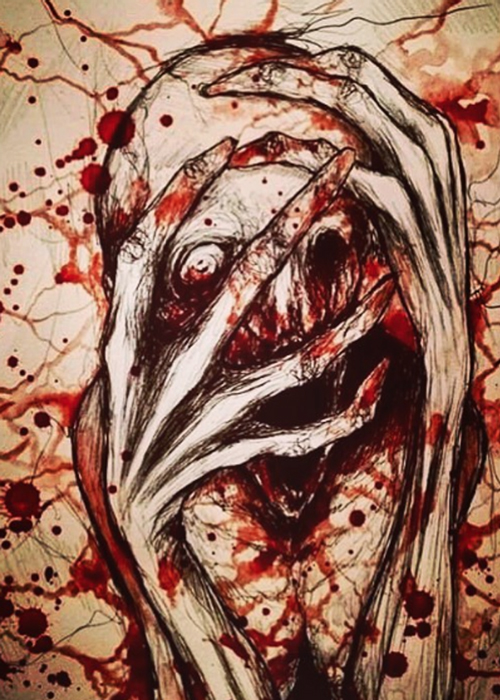
The majority of the film’s production is set for September 2019 at the state-of-the-art Redman Studios in Salt Lake City, Utah with Joe Olivas as the Director of Photography. The film can be expected to be wrapped with post-production sometime late in 2019 followed by the theatrical release later in 2020.
“Revisiting Poe’s The Tell Tale Heart is more than bringing a classic horror story to a new audience; it’s discovering a creative way to explore this classic psychological thriller,” the film’s website stated. “The narrative is enhanced through an unpredictable use of sound and light. The characters blend a modern sensibility with anachronistic charm as seen through an unsettling array of time and space, while a shifting setting disorients the unwitting audience. What is seen and what is heard leads the perplexed audience to ask… what is insanity and what truly constitutes reality?”
###
Media Contact
City Creek Media
Jared Christensen
jared@citycreekmedia.com
801-644-0601
The Tell-Tale Heart – The Film to Introduce Conscious Camera
by John Lindquist
May 14, 2019
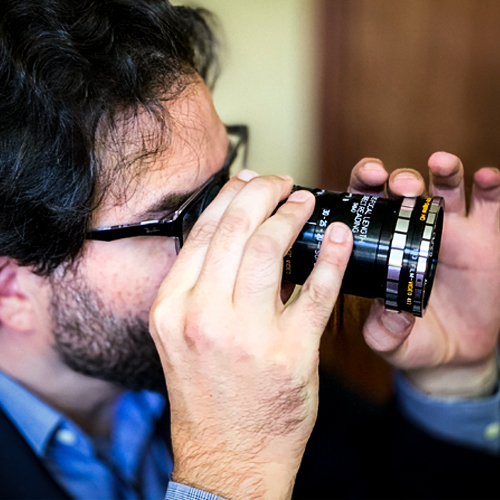
The upcoming production for the film The Tell-Tale Heart is generating buzz. Why are so many people excited about participating in an independent short film adaptation of Edgar Allan Poe’s The Tell-Tale Heart? The simple answer is that this isn’t just another use of Poe’s work as a cheap and easy dramatic outline. While this adaptation is a modernization of the classic, it remains steadfast in its commitment to Poe’s story, vision and style—nothing cheap or easy.
The more comprehensive answer why people want to be a part of this production are the director and his script. Director, McClain Lindquist, is the frontrunner in an offshoot of postmodernism in which the camera carries the weight of a character without being an actual character. This stylistic movement, coined “conscious camera”, employs the technique of using the camera as an accomplice in the story while not representing the point of view of an unseen character. What the camera shows, why it shows what it does, and the manner in which it shows actively connects to the story. Differing from subjective camera (or a first-person shot) that shows perspective from a specific psychical character, conscious camera is not a camera shot as stand-in, or neutral observer, or recorder of events. Conscious camera pushes beyond capturing the visual; through awareness of the camera itself, it reflects the emotions and thoughts portrayed in the story.
Lindquist developed the technique and style of conscious camera over a career of music videos and minor projects. As to why he chose The Tell-Tale Heart, Lindquist explained, “The psychological factors from the point of view of Poe’s narrator provide one of the best opportunities to explore [conscious camera].” Lindquist’s choice was both as an artist and a fan. “As a fan, I watched just about every version of The Tell-Tale Heart and while some have been close [to the original story], too many take a shortcut, or wander off in another direction. I wanted a definitive adaptation for modern audiences that stayed true to the short story.”
Which leads us to the screenplay adaptation. “I had these ideas about how I wanted the story told and what it would take to accomplish,” Lindquist shared, “but to get other people on board [making the film] I needed a script that captured my vision and how I would use the camera.” He didn’t have to go far to find a collaborator. “To help [with the script] I needed someone I could trust, and who knows how to write. The guy I chose happens to be my brother, John.”
The script did the trick. As it has made the rounds, industry people have been clamoring to be part of this project. “Camera, sound, music, special effects, artwork, graphics, production crew, studio, and actors,” Lindquist listed some positions filled or have applications under consideration. With production scheduled for Fall 2019, Lindquist has time, and ample interest, to be fastidious in who he chooses to be part of the project and its progressive conscious camera technique.
